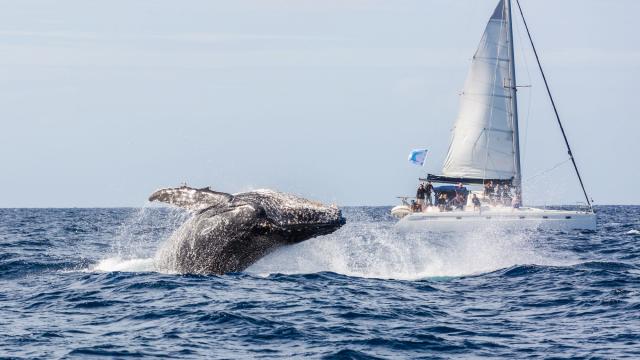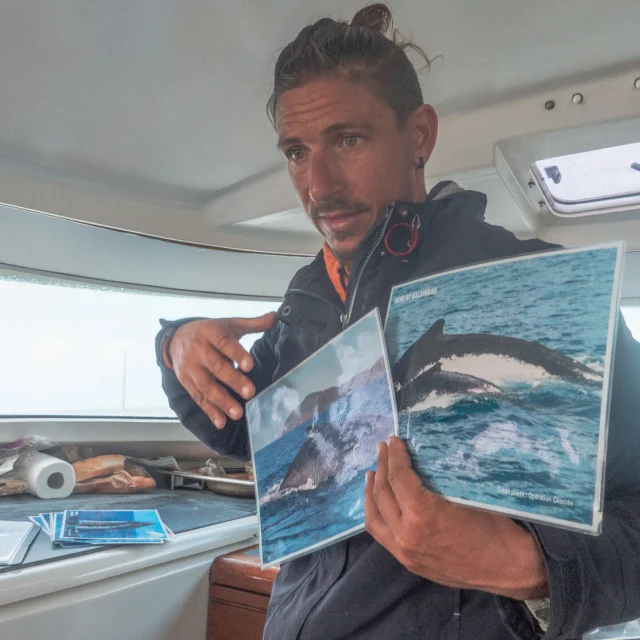 Observation des baleines - Yaté
Observation des baleines - Yaté  Observation des baleines - Yaté
Observation des baleines - Yaté  Baleine - Yaté
Baleine - Yaté Observation des baleines - Yaté
Observation des baleines - Yaté Humpback whales can be found all around Grande Terre, as well as on Île des Pins and the Loyalty Islands. You’ll have the best chance of spotting them in the Great South, off Prony Bay. Numerous nautical service providers offer eco-friendly whale-watching tours.
There are several ways to see humpback whales:
Departures by boat are from one of the ports in Nouméa. The trip takes place amidst splendid scenery, along the coasts of the Great South. If you haven’t got your sea legs, head for Cap N’Dua, in the Great South, where an observation centre has been set up at the lighthouse. Plan to spend a good amount of time there! Lastly, with a bit of luck, you might sometimes come across whales very close to Nouméa, when you head out early in the morning for a fishing or diving trip.
Note : there is, of course, no guarantee that you will see cetaceans on the day of your excursion. Most water sports providers will suggest rescheduling the trip (during the week) if the mammals don’t make an appearance.
For a day trip on a catamaran or motorboat, bring your picnic for lunch, a bottle of water, sunglasses, a hat, a windbreaker or sweater, sunscreen, binoculars, and your camera! No need to wear your best sneakers, you’ll be barefoot on the boat.
 Observation des baleines - Nouméa
Observation des baleines - Nouméa Baleine à Bosses - Nouméa
Baleine à Bosses - Nouméa Aire Aménagé Cap N'dua ©nctps
Aire Aménagé Cap N'dua ©nctpsHumpback whales are migratory marine animals. Every year during the austral winter, they travel over 8,000 kilometres to reach the warm waters of New Caledonia. It’s during this time that they reproduce, give birth and share the first days of their calves’ lives. The first arrivals are the mothers with their calves. They are followed by older individuals and young, still immature whales. The breeding males close the parade with the females that are resting from their reproductive cycle. In our Caledonian lagoon, whale watching starts in mid-July and ends in mid-September. Afterwards, the cetaceans head back to higher latitudes to feed.
Humpback whales fast for most of their migration and stay: they live off their blubber reserves for periods of up to eight months!
The humpback whales you’ll see belong to the mysticeti suborder. They are around 15 meters long and weigh between 30 and 40 tonnes. But what truly sets them apart are their massive pectoral fins. These fins measure almost one-third of the animal, around 5 meters! The whale’s back is gray, while its belly is black or white.
With the naked eye or binoculars, you’ll witness several types of behaviour:
Whales are unpredictable… and curious! Even if you have to keep a safe distance to avoid disturbing them, sometimes they will approach the boat, much to everyone’s delight! The guide who accompanies you will explain a number of cetacean behaviours. You’ll be able to interpret every gesture you observe.
 Baleine - Prony
Baleine - Prony Baleine - Prony
Baleine - Prony
Observing whales is an intense and unforgettable experience! However, it’s essential to remember that whale watching must be done with respect for marine animals. Cetaceans are sensitive to external disturbances. These disturbances can have a harmful impact on their reproduction and communication. That’s why, in New Caledonia, tourism operators, scientists, authorities, and environmental protection organisations work in close partnership to ensure their protection. An environmental code regulates the protection of these ocean giants.
The whale population that comes to New Caledonia every year forms a fairly stable and loyal community. Whale tracking carried out by scientists shows that some whales may have been observed about twenty times in a single season, while others have been seen several years in a row.